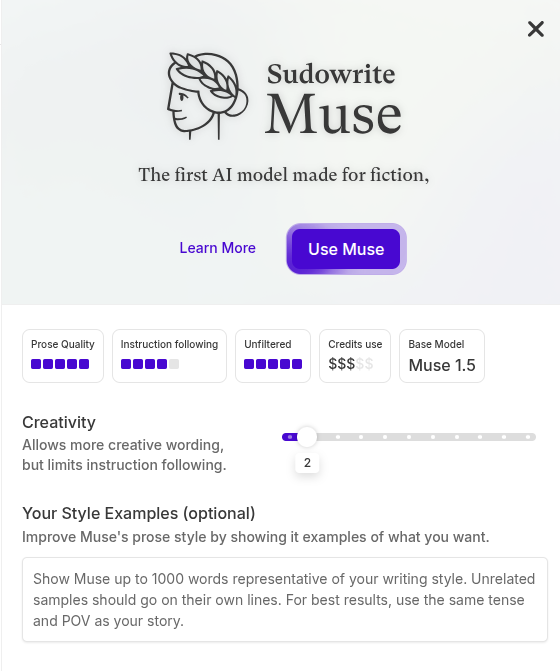
Sudowrite just released their new, updated version of Muse, their in-house generative AI model that’s optimized for writing fiction. It’s very similar to Muse 1.0, where you select a “creativity” setting from 1 to 11, optionally add some prose for it to work from, and then let it go. To allow their subscribers to experiment with it, they made it free to use today—but honestly, it doesn’t use a ton of credits anyway, so unless you’re on the cheapest plan (or generating a +1M word tome) it’s not going to break the bank.
I happened to be working on the rough AI draft of Captive of the Falconstar, so I decided to try it out. I wasn’t too impressed with the earlier version of muse, since I found that it didn’t have much internal consistency and felt a bit like it had just thrown my whole story bible into a blender. But perhaps the main problem was that I was setting the creativity too high. With Muse 1.5, I still ran into those problems on the higher range, but when I set creativity down to 1 or 2, it actually was fairly coherent (though the dialogue was still a bit like “let’s throw these characters in a blender and see what happens!”)
I think it might be that the way I’m writing my scene beats works better for the more reliable version of Muse. I tend to write very detailed scene beats, running in the 200 to 500 word range. I suspect that Muse would work much better if I were “discovery writing” my AI draft, instead of outlining it rigorously and generating multiple iterations of each chapter to pick out the best parts of each one. When you crank up things on the creative end, it can get pretty wild, especially on the 11 setting.
But while the internal consistency of the writing isn’t nearly as good with Muse as it is with Claude, the prose is definitely better. So what I’m probably going to do in the future is generate the first iteration of each chapter in Claude 4 Sonnet (or Opus, if I have enough credits for it—Opus is a monster of a credit spender, but the results are quite excellent! I really hope Sudowrite builds a “delux” model based on Claude 4 Opus.) After that, I’ll generate a couple of other iterations using Muse, then go through it line by line to copy-paste the best parts of the Muse iterations into the master version.
It’s a lot more work, but I think this way I can get the best aspects of both models, and produce a really clean AI draft. And the cleaner the AI draft is, the faster and easier it is to write the human draft—and likely with better results too.